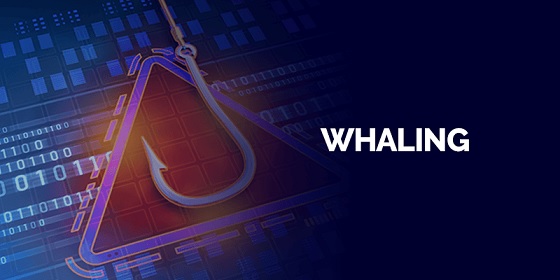High-level executives, such as CEOs and CFOs, are a common target for whaling attacks. Cybercriminals leverage personal information gleaned from social media to impersonate them to convince employees to carry out fraudulent wire transfers or share sensitive company data.
To prevent a successful attack, it is essential to foster an organizational email culture of “trust but verify.” Incorporate security awareness training and introduce data protection policies that monitor suspicious network activity.
Educate Your Employees
Whaling attacks target executives, managers, and other high-level employees to gain access to company data, financial information, or login credentials. Attackers can achieve this by impersonating their targets and requesting wire transfers or sensitive information the average employee cannot access.
Cybercriminals spend significant time researching their target before carrying out a whaling attack. They will explore an executive’s social media profiles and other publicly available online information to extract insights about their personality, which can be reflected in the attacker’s tailored email message. The attacker will also take great care to make the phishing email appear authentic and use the correct corporate logos and details to bolster its authenticity.
Educating your employees about how to prevent whaling attacks is one of the most important things you can do. To do so, you should conduct regular cybersecurity awareness training, including phishing simulations explicitly targeting your high-level staff.
Educating your employees about the risks associated with clicking on links or downloading attachments from suspicious emails is crucial, mainly when working remotely or on public Wi-Fi networks. Finally, you should also establish and implement data protection protocols to reduce the likelihood of an attack. These should include requiring multi-factor authentication for all accounts and using secure email gateways with powerful spam filters.
Implement Strong Internal Processes
Whaling attacks are sophisticated phishing attempts that take advantage of the trust and authority granted to high-ranking executives. These attackers know that these individuals are more likely to respond to requests for information or money than other employees because they have greater internal data access and often hold positions of responsibility within the organization.
Hackers use a combination of social engineering techniques to create emails that look authentic to the victim. They use the victim’s name, title, and essential job details to impersonate a fellow employee or manager. They also use spoofed addresses and company logos to make the email appear legitimate. These details are combined with a false sense of urgency and veiled threats to encourage the target to react quickly and without question.
Once the target has provided information to the cybercriminal, they can access an organization’s secure network and financial assets. They may also be able to use the victim’s identity to commit fraud, embezzlement, or theft of proprietary information.
The impact of whaling attacks on organizations is severe. They can lead to financial loss, damage to the company’s reputation, and even legal repercussions. This is why it’s so crucial that every employee understands the danger of whaling attacks and knows how to identify them. Regular cybersecurity awareness training and implementing robust safeguards can help protect against these attacks. If an incident does occur, your team must respond quickly to notify authorities and review and update policies to ensure this type of attack doesn’t happen again.
Secure Your Data
Cybercriminals are targeting the most lucrative targets possible. This is one reason why whaling attacks are so successful. Whaling is a highly personalized and targeted form of phishing, as attackers research their target organization and select specific individuals to attack. The attackers’ goals vary but can include financial gain by enabling unauthorized wire transfers or redirecting payments. They can also steal personal employee information for future attacks or blackmail victims. Another goal is to harvest login credentials and email addresses to access high-level systems or databases.
The primary way to prevent a whaling attack is to have robust cybersecurity protocols in place and follow them consistently. Educating employees on recognizing a whaling attack and implementing training on the topic is a crucial first step. In addition, organizations should employ robust spam filters and secure email gateways to prevent malware from entering an employee’s inbox. Companies must use common email authentication standards such as SPF, DKIM, and DMARC to prevent hackers from forging an employee’s email address.
Additionally, employees should always be on the lookout for suspicious requests and trust their instincts. If a request seems off, double-check through another channel or wait until the issue can be verified. This will help protect the company and its employees from costly data breaches and other damage.
Secure Your Network
Cybercriminals can use a whaling attack to gain access to classified information, gain financial gains, or get personal data from employees. They usually impersonate a high-ranking executive, such as the CEO or C-suite. They can also spoof the email address to appear as a trusted colleague. This can include corporate logos and other details to make it look authentic.
Before carrying out a whaling attack, cybercriminals do their research. They may look at the target’s social media for information, such as birthdays, hobbies, and addresses. They can also glean information through physical and social engineering at places the victim frequents. Once they have enough info, they create a tailored message to convince the victim to provide confidential information.
This is why it’s essential to have secure networks and implement best practices for email communication. Employees should be taught to look at the sender’s domain name, avoid unsolicited attachments, and verify unusual requests through a different channel, like a phone call or in person. In addition, organizations should use tools that detect anomalous user behavior and prevent users from downloading unsanctioned software continuously.
While a phishing attack might be a minor nuisance for an average company, it can be much more damaging to a business with a large audience. A whaling attack can lead to losing consumer confidence, brand reputation, and revenue. Fortunately, several strategies can help to prevent whaling attacks. By implementing these tips and making your team aware of the risks, you can protect your organization from this dangerous form of malware.





